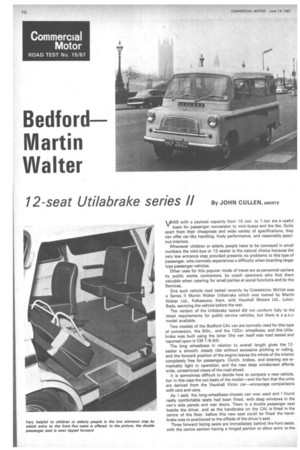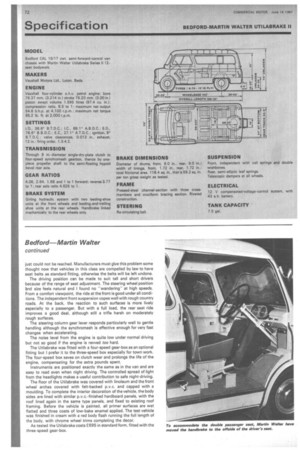Bedford Martin Walter
Page 72

Page 73

Page 74

If you've noticed an error in this article please click here to report it so we can fix it.
12-seat Utilabrake series II By JOHN CULLEN,AmiRrE VANS with a payload capacity from 15 cwt. to 1-ton are a useful
basis for passenger conversion to mini-buses and the like. Quite apart from their cheapness and wide variety of specifications, they can offer car-like handling, lively performance, and reasonably spacious interiors.
Whenever children or elderly people have to be conveyed in small numbers the mini-bus or 12-seater is the natural choice because the very low entrance step provided presents no problems to this type of passenger, who normally experiences a difficulty when boarding larger type passenger vehicles.
Other uses for this popular mode of travel are as personnel carriers by public works contractors, by coach operators who find them valuable when catering for small parties at social functions and by the Services.
One such vehicle road tested recently by COMMERCIAL MOTOR was a Series II Martin Walter Utilabrake which was loaned by Martin Walter Ltd., Folkestone, Kent, with Vauxhall Motors Ltd., Luton, Beds, servicing the vehicle before the test.
The version of the Utilabrake tested did not conform fully to the latest requirements for public service vehicles, but there is a p.s.v. model available.
Two models of the Bedford CAL van are normally used for this type of conversion, the 90in., and the 102in. wheelbase, and this Utilabrake was built using the latter (the van itself was road tested and reported upon in CM 7-8-64).
The long wheelbase in relation to overall length gives the 12seater a smooth, steady ride without excessive pitching or rolling, and the forward position of the engine leaves the whole of the interior completely free for passengers. Clutch, brakes, and steering are remarkably light in operation, and the new deep windscreen affords wide, unrestricted views of the road ahead.
It is sometimes difficult to decide how to compare a new vehicle, but in this case the van basis of the model—and the fact that the units
are derived from the Vauxhall Victor car encourage comparisons with cars and vans, As I said, the long-wheelbase-chassis van was used and I found really comfortable seats had been fitted, with deep windows in the van's side panels and rear doors. There is a double passenger seat beside the driver, and as the handbrake on the CAL is fitted in the centre of the floor, before this new seat could be fitted the handbrake was re-positioned to the offside of the driver's seat.
Three forward facing seats are immediately behind the front seats, with the centre section having a hinged portion to allow entry to the rear six seats, which are side-facing, accommodating three passengers each side. One can also get to these seats through the rear doors which have a fold-down step. Including the driver, 12 seated passengers can be accommodated quite comfortably in the contoured seats, which do not allow passengers to sway about during normal driving.
The carrying capacity is 12.5 cwt. and for the test sand-filled sacks brought the vehicle up to the gross weight of 2 tons. Fuel consumption figures differed slightly from the van. On the four stops a mile test with the vehicle fully laden, 21 m.p.g. was recorded with the average speed 18.5 m.p.h. Driven over the same route 18.6 m.p.g. was returned on the earlier test of the van, with the average speed 23.7 mph.
A high-speed motorway test over 16 miles fully laden was carried out on the M1 and 20.4 m.p.g. was the Utilabrake's fuel consumption -average speed 57.1 m.p.h. Comparing the fuel consumption figures recorded for the four stops a mile, and high-speed motorway driving, the Utilabrake grossing two tons will be an economical vehicle to operate. While motorway driving, the 1,595 c.c. engine and the four speed gear-box took all the small gradients in its stride and was never at any time overtaxed. In fact it was the 70 m.p.h. limit which controlled the top speed!
One annoying point particularly noticeable on the motorway was that I could see very little of the overtaking traffic because of the smallness of the mirrors. More than once before changing lanes I had to turn my head to make sure that it was safe. Replacing the round mirrors by 7in. by 5in. mirrors would give a better view.
Braking was very good, once after a stop on a dry road from 20 m.p.h. a slight smell of burned rubber reached the driving compartment. Part of the tyre's tread pattern was found clinging to the road! The Utilabrake stopped in 21 ft. without any sliding, wheel locking, or pull either way. A distance of 45 ft., was measured after a stop from 30 m.p.h. and Tapley readings of 96 per cent, and 85 per cent respectively were obtained, well inside the requirements of the braking regulations coming into effect in January 1968.
A ready climber
For the hill climb test I chose Bison Hill in Dunstable because of its average gradient of 1 in 10 over its three-quarter miles and the maximum on a short stretch is 1 in 6.5. From a standstill at the bottom a maximum power ascent was made in 2 min. 16 secs. The lowest gear used was second for 19.9 secs. and the minimum speed 18 m.p.h. To many this means little but what it shows is that the Utilabrake will not prove a hindrance to other road users on such gradients.
During stop and restart tests using the steepest section of the hill, the Utilabrake would not -look at it" in second gear but pulled away quite happily in first. A handbrake hold test was carried out and although operated with the right hand as opposed to left hand operation in some vehicles this new position proved quite acceptable and the vehicle was safely held on the steepest section-with notches to spare!
Down the hill a stop was made on the 1 in 6 gradient, and a similarly easy start was made in reverse gear. A brake fade test was carried out cruising down Bison Hillin top gear for part of the way with the speed of the vehicle corrected to 20 m.p.h. by lightly applying the foot brake. It only took 1 min. 48 sec. to reach the bottom of the hill, top gear being held for 47 sec.
When a full pressure brake stop was made at the end of the run down, a Tapley meter reading of 86 per cent showed only a drop of 10 per cent over the cold drum brake test.
Fuel consumption runs were made on part of the A6 from north of Barton,. in Bedfordshire, to Clophill village. An out-and-return run of three miles each way was made over this section, with a triangle turning at each end. The usual procedure was carried out, and on the runs with one and four stops a mile, each stop was of 15 secs., when the engine was left idling. The fuel consumption figures varied slightly from the van's but this was probably due to different traffic conditions.
The Utilabrake has seat belts for the driver and the front passenger nearest the door, but I found that if the belts were fastened securely enough for comfortable driving, some dashboard controls just could not be reached. Manufacturers must give this problem some thought now that vehicles in this class are compelled by law to have seat belts as standard fitting, otherwise the belts will be left undone.
The driving position can be made to suit tall and short drivers because of the range of seat adjustment. The steering wheel position bnd size feels natural and I found no "wandering" at high speeds. From a comfort viewpoint, the ride at the front is good under all conditions. The independent front suspension copes well with rough country roads. At the back, the reaction to such surfaces is more lively especially to a passenger. But with a full load, the rear seat ride improves a good deal, although still a trifle harsh on moderately rough surfaces.
The steering column gear lever responds particularly well to gentle handling although the synchromesh is effective enough for very fast changes when accelerating.
The noise level from the engine is quite low under normal driving but not so good if the engine is revved too hard.
The Utilabrake was fitted with a four-speed gear-box as an optional fitting but I prefer it to the three-speed box especially for town work. The four-speed box saves on clutch wear and prolongs the life of the engine, compensating for the extra pounds spent.
Instruments are positioned exactly the same as in the van and are easy to read even when night driving. The controlled spread of light from the headlights makes a useful contribution to safe night-driving.
The floor of the Utilabrake was covered with linoleum and the front wheel arches covered with felt-backed p.v.c. and capped with a moulding. To complete the interior decoration of the vehicle, the body sides are lined with similar p.v.c.-finished hardboard panels, with the roof lined again in the same type panels, and fixed to existing roof framing. Before the vehicle is painted, all primer surfaces are wet flatted and three coats of low-bake enamel applied. The test vehicle was finished in cream with a red body flash running the full length of the body, with chrome wheel trims completing the decor.
As tested the Utilabrake costs £695 in standard form, fitted with the three-speed gear-box.




































































































































